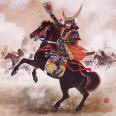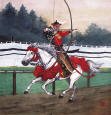 |
|
 |
|
|
|
Armor of the Samurai The armor a samurai wore "was...essentially a garment composed of overlapping strips or 'scales' of steel-on-leather laced together with thongs of leather, fiber, or silk..."(King, pg 62). The steel itself was lacquered as a precaution to prevent rust. In later centuries steel was used only in vital areas, since it was so heavy, as bullet proof armor. The entire suit of armor was called yoroi in early centuries and was a boxy design, the simpler design used in more recent centuries was called do-maru. In most cases armor was only worn for full scale battles or special ceremonies.
| ||||||||||||||
|
Web site designed and researched by Travis Moorhouse Last updated Monday, December 04, 2006 |